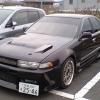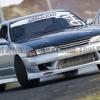R33 Bits, Lots Of Other Stuff As Well
Announcements
-
Similar Content
-
Latest Posts
-
On my daily early morning walk I take few different routes to get to the top of a locally famous hill (and park land) and on the way up there's these two rusted out - but not abandoned - Nissan Laurels. I've lived in this area for the last 10 years and always seen both of them parked there whenever I passed. But checking on Google street view it shows that both cars have been there from at least 2015, and the one on the left (reverse parked) has been there since at least 2011... There's a sign in the back window of the car on the right that says in English (not Japanese) "Do not touch - Not for sale". So there's probably been a few people asking about them over the years. I took photos of these Laurels last year and posted them up in the Japan Scrapbook thread at the time but this time the grass has been cut and can get a better view of the cars, which also revealed a chain linking the suspension arms of both cars together as a simple anti-theft deterrent.
-
As long as the website doesn’t crash again
-
By soviet_merlin · Posted
Hmpf, that doesn't sound great. That makes it feel like it might be better to put the money towards a track day instead. It didn't seem that bad the two years before. As Brett mentioned it'll be on the roll racing website. Sale starts 6pm on Wednesday. Tickets may sell out quickly so if you want to go, set an alarm and get them at that time -
The connector led to nowhere, are you talking about which wires it was spliced into?
-










Recommended Posts
Create an account or sign in to comment
You need to be a member in order to leave a comment
Create an account
Sign up for a new account in our community. It's easy!
Register a new accountSign in
Already have an account? Sign in here.
Sign In Now